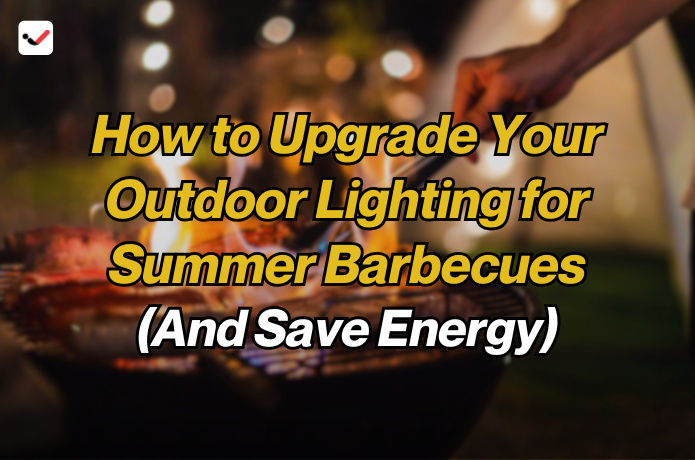How to Upgrade Your Outdoor Lighting for Summer Barbecues (And Save Energy)
How to Upgrade Your Outdoor Lighting for Summer Barbecues (And Save Energy)

Summer barbecues are a favorite way to bring people together. With warm evenings and longer days, it’s the perfect season to relax outside with friends and family. But if your backyard lighting is outdated, dim, or wasting energy, it can take away from the experience. Good outdoor lighting makes your space more inviting and helps your guests feel safe and comfortable after the sun goes down.
Upgrading your outdoor lighting can also save you money on your energy bills. You don’t have to spend a lot or install anything too fancy. With a few smart changes, you can light up your yard beautifully and efficiently. Let’s explore how to make your outdoor space shine for your next summer barbecue without using too much electricity.
1. Use LED Lights Instead of Incandescent Bulbs
LED light bulbs are one of the easiest ways to upgrade your outdoor lighting. They use up to 80% less energy than traditional incandescent bulbs and last much longer [4]. You can use LED string lights, pathway lights, or even LED floodlights to brighten large areas. LED lights are also cooler to the touch and better for the environment.
Look for outdoor-rated LED bulbs that are waterproof and built to handle weather changes. Replacing all your old outdoor lights with energy-efficient LEDs is a great first step.
2. Install Solar-Powered Garden Lights
Solar-powered outdoor lights are perfect for saving energy. They charge during the day using sunlight and automatically turn on when it gets dark. These lights are easy to install, require no wiring, and can be moved around your yard as needed.
Use solar path lights to line walkways or garden borders. You can also use solar spotlights to highlight trees, plants, or outdoor décor. Many solar lights now come with LED bulbs, combining both solar power and LED energy savings for maximum efficiency.
3. Add Motion Sensor Lights
Motion sensor lights are smart for both energy saving and security. These lights only turn on when someone walks by, which means they’re not using power all night. They’re great for areas like the garage, side yard, or entryways where you don’t need constant light.
Modern motion sensor lights can be found in sleek designs and come with energy-saving features. Choose models with adjustable sensitivity and time settings so you can control how long they stay on.
4. Use Timers or Smart Plugs
A common problem with outdoor lighting is forgetting to turn it off. Using timers or smart plugs can fix this. Timers let you set your lights to turn on and off automatically at certain times. Smart plugs go a step further, letting you control your lights from a smartphone app.
You can even connect multiple lights to one smart plug and create a schedule. This way, you never have to worry about lights staying on all night, and you keep your energy use in check.
5. Choose Energy Star Certified Fixtures
When shopping for new lighting fixtures, look for the Energy Star label. These products meet strict guidelines for energy efficiency set by the U.S. Environmental Protection Agency [4]. Energy Star outdoor lights use less electricity and often include LED technology and smart sensors.
From wall lanterns to spotlights, there are Energy Star-rated options in every style. Choosing certified products helps you save energy while still enjoying a well-lit space.
6. Create Zones with Task Lighting
Think about how your outdoor area is used during a barbecue. Do you need strong lighting for the grill? Softer light near the seating area? Use different types of lighting for each space. This is called task lighting.
Focused light where you need it most prevents you from lighting up the entire yard unnecessarily. Use brighter lights near cooking stations, and dimmer, ambient lights near tables and lounge areas. This approach keeps energy use down while still making every part of your yard useful and enjoyable.
7. Reflect and Amplify Light
You don’t always need more lights to make a space brighter. Use light-colored surfaces, mirrors, or even aluminum reflectors to bounce light around your yard. Painting fences or walls with lighter colors can also help spread the light better.
This simple trick helps reduce the number of fixtures you need and makes your current lighting work harder without adding to your energy bill.
8. Choose Low-Voltage Lighting Systems
Low-voltage lighting systems use less electricity than standard 120-volt systems. They’re safer to install yourself and are perfect for outdoor use. These systems often run on 12 or 24 volts and work well for landscape lighting, decks, and patios.
You can connect several low-voltage lights to one transformer, which reduces energy use and simplifies your setup. Many models also include dimmers or sensors for added efficiency.
9. Upgrade Outdoor Light Controls
Today’s outdoor lighting controls give you more options than ever. From dusk-to-dawn sensors to voice-controlled smart hubs, these tools help automate your lighting and reduce energy waste.
Voice assistants like Alexa or Google Home can control smart outdoor lights with a simple command. You can group lights by zone, set scenes for events, or turn everything off at once when the party ends.
10. Keep Fixtures Clean and Well-Maintained
Dirty or broken fixtures waste energy by reducing light output. Clean your outdoor lights regularly to remove dust, bugs, and debris. Replace cracked covers and make sure all connections are tight and safe.
A well-maintained lighting setup works better, looks better, and doesn’t need to be replaced as often. This saves you both energy and money in the long run.
Upgrading your outdoor lighting for summer barbecues is about more than just good looks. It’s also a chance to make your home more energy efficient. By switching to LED lights, using smart controls, and installing solar-powered options, you can enjoy long summer nights without the high electricity costs.
Start small—maybe by replacing a few old bulbs or adding a timer. Over time, your yard will become both a fun party space and a smart energy-saving zone. That’s a win for your wallet, your guests, and the planet.

